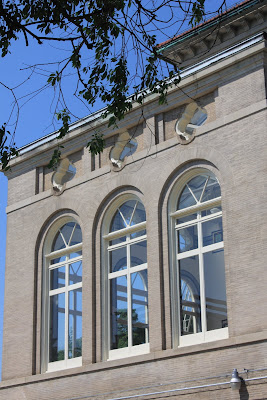
Visions of a "world class" waterfront destination along the Washington Channel in Southwest had been dancing in developers' heads for years before a contract was awarded by the District
in 2008. On June 28th the winning team's vision became more clear when
PN Hoffman and
Madison Marquette filed a preliminary report with the
D.C. Zoning Commission, clarifying its plans for the 52 acres (including build out on the water) that will be radically revamped as
"The Wharf" to be constructed in three phases over the next 10 years.
Phase one of the project - encapsulated for approval as the "Stage 1 PUD" - will be reviewed by the Commission on July 18th. In addition to reviewing Stage 1, the Commission will rule on the request to rezone the area from R-3 to C-3-C on land, and from unzoned to W-1 in the water.

If approved, the initial stage will be valid for 18 months, allowing developers that long to submit the final
Master Plan to the office of the
Deputy Mayor's for Planning and Economic Development (DMPED) for approval. Construction of the first phase is projected to begin in late 2012, and is expected to last until 2016. In those four years, phase two will undergo the review and approval process.
Phase 1 will begin in the middle section, roughly from 7th Street to 9th Street, in between the entertainment-heavy section closest to I-395, which focuses on water-transit-oriented piers and redevelopment of the Municipal Fish Market (phase two), and the residential area at the southern end (phase three). Redevelopment of the Municipal Fish Market will take place in phase 2.
Phase one includes the restructuring of portions of 7th, 9th, N St and M Place; a new Capital Yacht Club; two new piers - "City Pier" off of 9th and "7th Street Pier" - and a major infrastructure overhaul of Water Street. The grand scheme is to turn Water Street into a promenade with 60' of width shared between pedestrians, streetcars, bikes and outdoor diners.

The parcels in phase one (2,3,4 and 5) will be developed as office, retail, residential and hotel space. Parcels 3 through 5 could potentially be 130' high, as is permitted in a C-3-C zone. The plan shows that parcels 3 and 4 will have ground floor retail and office and/or residential towers, parcel 5 will hold two hotels, and parcel 2 is slated to become a concert/entertainment venue with seating for 4,000 to 6,000.

Parcel 3, at the corner of Maine Avenue and 9th Street, has been claimed in part by
the Graduate School USA, which will take up 190,000 s.f. of space and operate 18 hours a day. A temporary
Kastles Stadium, now located near parcel at 9th and Maine Street and intended to be temporary, is now being considered for parcel 2.
Holland & Knight, legal counsel for PN Hoffman and Madison Marquette, submitted the project's prehearing statement to the Commission in May, and the more recent "20 day [in advance of hearing] submission" on June 28th. Significant changes in both prehearing documents that will affect phase one include a decreased F.A.R. (floor area ratio), the removal of residential use at parcel 5, reduced parking spaces and increased bike docking areas. Most encouraging is the reduction of subsidized housing required by the District from 30% to 20% of total housing.

A community workshop was given by the developers on June 7, where several issues were raised, most of them surrounding the riparian development, including the depth of the channel, and the extended length of several piers, which cuts the width of the channel from 400' to 200' wide.
Subsequent development will include a revamped Banneker Park and the
Southwest Ecodistrict of 10th Street (not controlled by Team Wharf), which will ideally provide a link from the waterfront to the Mall.
Other elements of the overall development (all three phases) include a combined 3.2 million s.f. gross floor area (3.87 F.A.R.), 8 to 12 acres of park/open space with "programmed public activities" catering to year-round use, 625 hotel rooms, 1,200 "mixed-income" residential units, and 400 to 500 Marina Slips
The entire project is estimated to need $2 billion; the District pledged $200 million in 2008 in tax increment financing. The redevelopment, say developers, has the potential to bring in $40 million in tax revenue annually.
ANC 6D will hold a meeting, in advance of the Zoning Commission hearing, at the
Dept. of Consumer and Regulatory Affairs (DCRA) at 7pm, next Monday, July 11th.
Washington D.C. real estate development news
 Ward 8 has the lowest home ownership levels in the city, by far, and Councilman Marion Barry has a solution: Stop building rental property. Barry has proposed a bill that would prohibit construction permits for new apartment buildings within his ward.
Ward 8 has the lowest home ownership levels in the city, by far, and Councilman Marion Barry has a solution: Stop building rental property. Barry has proposed a bill that would prohibit construction permits for new apartment buildings within his ward.



















 Herman
Herman 



























